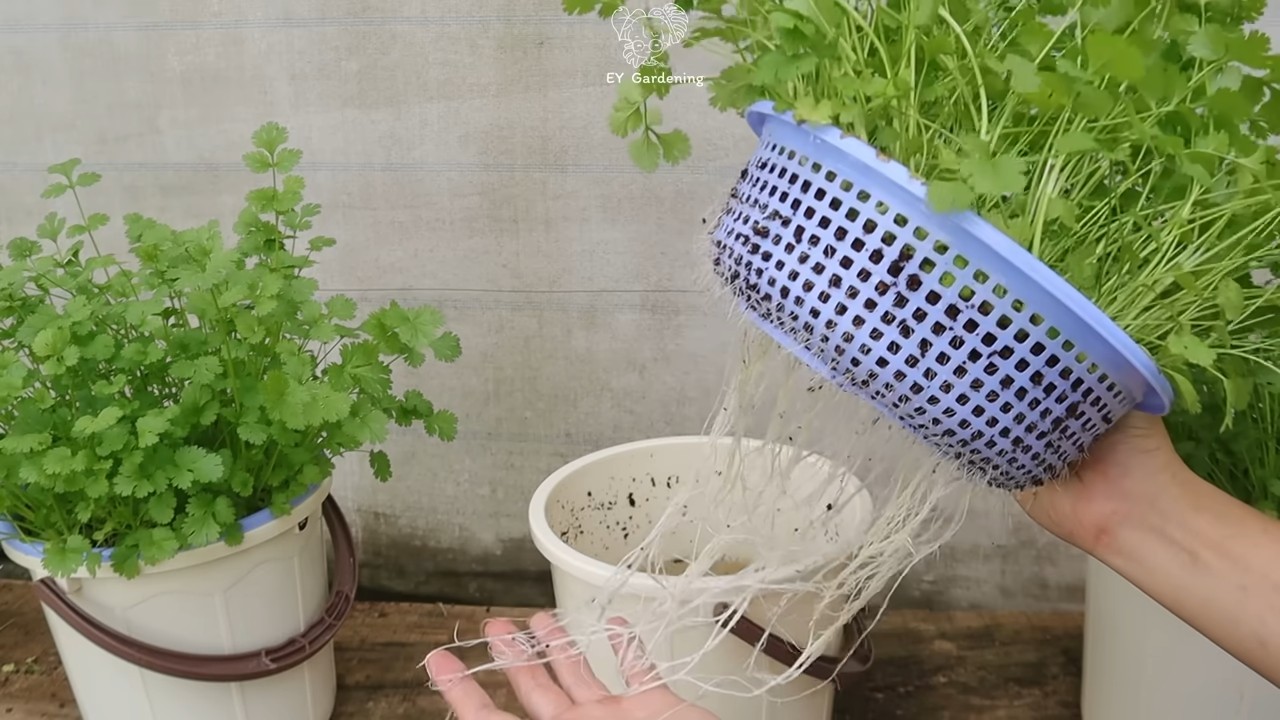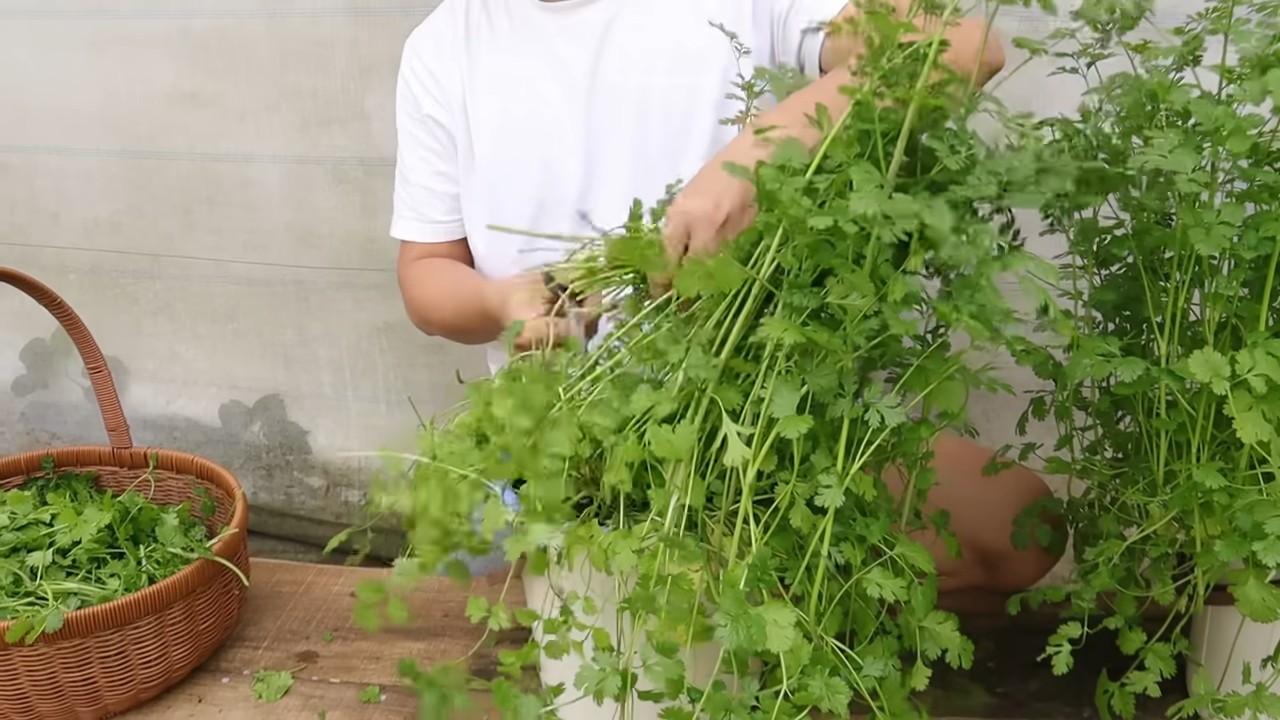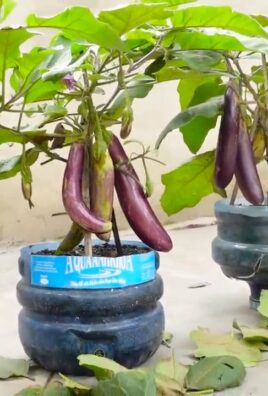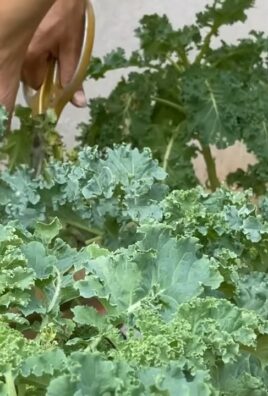Growing Coriander in Water: Unlock the secrets to effortlessly cultivating this fragrant herb right in your own kitchen! Have you ever dreamed of snipping fresh coriander leaves whenever you need them, without even stepping outside? I know I have! Imagine the burst of flavor you can add to your favorite dishes, all thanks to a simple, sustainable, and incredibly rewarding DIY project.
Coriander, also known as cilantro, has a rich history dating back thousands of years. Evidence suggests its use in ancient Egypt, and it’s been a staple in cuisines across the globe, from Latin America to Southeast Asia. For centuries, people have valued coriander for its medicinal properties and its ability to elevate the taste of countless recipes. But did you know that you don’t need a sprawling garden to enjoy its fresh, vibrant flavor?
In today’s fast-paced world, many of us lack the time or space for traditional gardening. That’s where this DIY trick comes in! Growing Coriander in Water offers a fantastic solution for urban dwellers, apartment residents, or anyone who wants a low-maintenance way to enjoy fresh herbs. This method not only saves space and time but also reduces waste and promotes a more sustainable lifestyle. Plus, it’s incredibly satisfying to watch your coriander thrive with minimal effort. So, let’s dive in and discover how you can easily grow your own supply of fresh coriander, right from your countertop!

Koriander in Wasser ziehen: Ein DIY-Guide für frischen Koriander ohne Erde
Hey Leute! Habt ihr auch manchmal das Problem, dass ihr nur eine kleine Menge Koriander für ein Gericht braucht und der Rest im Kühlschrank vergammelt? Oder dass der Koriander aus dem Supermarkt einfach nicht so aromatisch ist, wie er sein sollte? Dann habe ich die perfekte Lösung für euch: Koriander in Wasser ziehen! Ja, ihr habt richtig gehört. Ihr braucht keine Erde, keine komplizierten Anbausysteme. Nur Wasser, ein paar Korianderstängel und ein bisschen Geduld. Ich zeige euch, wie es geht!
Was ihr braucht:
* Frische Korianderstängel: Am besten vom Supermarkt oder Wochenmarkt. Achtet darauf, dass sie noch Wurzeln haben oder zumindest kleine Wurzelansätze. Je frischer, desto besser!
* Ein Glas oder eine Vase: Die Größe hängt davon ab, wie viele Stängel ihr ziehen wollt.
* Wasser: Leitungswasser ist in der Regel ausreichend.
* Ein sonniger Platz: Ein Fensterbrett ist ideal.
* (Optional) Flüssigdünger: Für eine extra Portion Nährstoffe.
Die Vorbereitung:
Bevor wir loslegen, ist es wichtig, die Korianderstängel richtig vorzubereiten. Das ist der Schlüssel zum Erfolg!
1. Korianderstängel auswählen: Sucht euch die kräftigsten Stängel aus. Sie sollten gesund aussehen, keine gelben oder braunen Blätter haben und idealerweise bereits kleine Wurzeln besitzen. Wenn die Stängel sehr lang sind, könnt ihr sie etwas kürzen, um die Energie auf die Wurzelbildung zu konzentrieren.
2. Blätter entfernen: Entfernt die unteren Blätter der Stängel, damit sie nicht im Wasser faulen. Lasst nur die oberen Blätter übrig. Das verhindert auch, dass das Wasser schnell schlecht wird.
3. Stängel reinigen: Spült die Stängel vorsichtig unter fließendem Wasser ab, um eventuelle Schmutzreste zu entfernen.
Koriander in Wasser ziehen: Schritt-für-Schritt-Anleitung
Jetzt kommt der spannende Teil: Das Einsetzen der Korianderstängel ins Wasser. Keine Sorge, es ist wirklich kinderleicht!
1. Glas vorbereiten: Füllt das Glas oder die Vase mit frischem Leitungswasser. Achtet darauf, dass das Wasser nicht zu kalt ist. Zimmertemperatur ist ideal.
2. Koriander einsetzen: Stellt die Korianderstängel so in das Glas, dass die unteren Enden im Wasser stehen. Die Blätter sollten nicht im Wasser sein, da sie sonst faulen könnten.
3. Standort wählen: Stellt das Glas an einen hellen, sonnigen Platz. Ein Fensterbrett ist perfekt. Koriander braucht viel Licht, um gut zu wachsen. Vermeidet aber direkte Mittagssonne, da diese die Blätter verbrennen kann.
4. Wasser wechseln: Wechselt das Wasser alle ein bis zwei Tage, um Fäulnis zu vermeiden und die Wurzelbildung zu fördern. Frisches Wasser hält den Koriander gesund und munter.
5. Geduld haben: Jetzt heißt es abwarten und Tee trinken (oder Koriandertee!). Es kann ein paar Tage bis Wochen dauern, bis sich neue Wurzeln bilden. Habt Geduld und gebt nicht auf!
Die Pflege:
Damit euer Koriander prächtig gedeiht, solltet ihr ein paar Dinge beachten:
* Regelmäßiger Wasserwechsel: Wie bereits erwähnt, ist ein regelmäßiger Wasserwechsel entscheidend.
* Licht: Koriander braucht viel Licht. Wenn euer Fensterbrett nicht genug Licht abbekommt, könnt ihr eine Pflanzenlampe verwenden.
* Dünger (optional): Wenn ihr möchtet, könnt ihr dem Wasser alle paar Wochen einen Tropfen Flüssigdünger hinzufügen. Das gibt dem Koriander einen zusätzlichen Wachstumsschub. Achtet aber darauf, den Dünger sparsam zu verwenden, da zu viel Dünger schädlich sein kann.
* Blätter ernten: Sobald die Korianderpflanze groß genug ist, könnt ihr die Blätter ernten. Schneidet die Blätter am besten mit einer Schere ab, um die Pflanze nicht zu beschädigen. Erntet immer nur so viele Blätter, wie ihr gerade braucht, damit die Pflanze weiterwachsen kann.
Häufige Probleme und Lösungen:
Auch beim Korianderziehen in Wasser können Probleme auftreten. Hier sind ein paar häufige Probleme und wie ihr sie lösen könnt:
* Fäulnis: Wenn das Wasser trüb wird oder die Stängel faulen, wechselt das Wasser sofort und entfernt die betroffenen Stängel. Achtet darauf, dass die Blätter nicht im Wasser stehen.
* Gelbe Blätter: Gelbe Blätter können ein Zeichen für zu wenig Licht oder Nährstoffmangel sein. Stellt die Pflanze an einen helleren Ort und gebt gegebenenfalls etwas Dünger hinzu.
* Keine Wurzelbildung: Wenn sich nach ein paar Wochen immer noch keine Wurzeln gebildet haben, versucht es mit frischeren Stängeln oder wechselt das Wasser öfter. Manchmal braucht es einfach etwas länger.
Koriander vermehren:
Wenn euer Koriander gut wächst, könnt ihr ihn sogar vermehren! Das geht ganz einfach:
1. Stängel schneiden: Schneidet einen gesunden Stängel von der Mutterpflanze ab. Der Stängel sollte mindestens 5 cm lang sein und ein paar Blätter haben.
2. In Wasser stellen: Stellt den Stängel in ein Glas mit Wasser.
3. Wurzeln bilden lassen: Wartet, bis sich Wurzeln gebildet haben. Das kann ein paar Tage bis Wochen dauern.
4. Einpflanzen (optional): Sobald die Wurzeln ausreichend lang sind, könnt ihr den Stängel in Erde einpflanzen. Das ist aber nicht unbedingt notwendig, ihr könnt den Koriander auch weiterhin im Wasser ziehen.
Koriander ernten und verwenden:
Das Beste am Korianderziehen in Wasser ist natürlich, dass ihr immer frischen Koriander zur Hand habt!
* Ernten: Erntet die Blätter, sobald die Pflanze groß genug ist. Schneidet die Blätter am besten mit einer Schere ab, um die Pflanze nicht zu beschädigen.
* Verwenden: Koriander ist vielseitig einsetzbar. Er passt hervorragend zu asiatischen Gerichten, mexikanischen Speisen, Salaten, Suppen und vielem mehr. Probiert es einfach aus!
* Aufbewahren: Frischer Koriander hält sich am besten im Kühlschrank. Wickelt die Blätter in ein feuchtes Papiertuch und legt sie in einen Plastikbeutel. So bleiben sie ein paar Tage frisch.
Warum Koriander in Wasser ziehen?
Es gibt viele Gründe, warum ich das Korianderziehen in Wasser so toll finde:
* Einfach und unkompliziert: Es ist wirklich kinderleicht und erfordert keine besonderen Kenntnisse oder Materialien.
* Platzsparend: Ihr braucht nur ein Glas und ein Fensterbrett.
* Immer frischer Koriander: Ihr habt immer frischen Koriander zur Hand, wenn ihr ihn braucht.
* Nachhaltig: Ihr vermeidet unnötige Lebensmittelverschwendung und spart Geld.
* Dekorativ: Ein Glas mit Koriander sieht auch noch hübsch aus!
Zusätzliche Tipps und Tricks:
* Verschiedene Sorten: Es gibt verschiedene Koriandersorten. Probiert verschiedene Sorten aus, um herauszufinden, welche euch am besten schmeckt.
* Korianderblüten: Wenn euer Koriander blüht, könnt ihr die Blüten auch verwenden. Sie haben einen ähnlichen Geschmack wie die Blätter.
* Koriandersamen: Wenn ihr die Blüten nicht erntet, bilden sich Koriandersamen. Diese könnt ihr trocknen und als Gewürz verwenden.
* Korianderöl: Ihr könnt auch Korianderöl selbst herstellen. Gebt einfach ein paar Korianderblätter in eine Flasche mit Olivenöl und lasst das Öl ein paar Wochen ziehen.
Ich hoffe, dieser Guide hat euch geholfen und ihr habt bald euren eigenen frischen Koriander zu Hause! Viel Spaß beim Ausprobieren! Lasst mich wissen, wie es bei euch funktioniert hat!

Conclusion
So, there you have it! Growing coriander in water is not just a quirky experiment; it’s a genuinely effective and rewarding way to ensure a constant supply of fresh, flavorful herbs right at your fingertips. Forget those wilting bunches from the grocery store that seem to expire the moment you get them home. This method offers a sustainable, cost-effective, and incredibly convenient solution for any home cook or gardening enthusiast.
The beauty of this DIY trick lies in its simplicity. You don’t need a green thumb, specialized equipment, or a sprawling garden. All you need is a jar, some water, and a little bit of patience. The visual appeal of watching the roots develop and the vibrant green leaves unfurl is an added bonus, bringing a touch of nature indoors.
But the benefits extend beyond mere convenience and aesthetics. By growing your own coriander in water, you have complete control over its quality. You know exactly what you’re putting into it (or rather, not putting into it – no pesticides or harmful chemicals here!). This translates to a healthier, more flavorful herb that will elevate your culinary creations.
Why is this a must-try? Because it’s a game-changer for anyone who loves fresh coriander. It eliminates waste, saves money, and provides a continuous supply of this essential herb. Plus, it’s incredibly satisfying to harvest your own homegrown ingredients.
Looking for variations? Experiment with different types of containers. While a simple glass jar works perfectly, you could also use a repurposed plastic bottle or even a decorative vase. Consider adding a diluted liquid fertilizer to the water every few weeks to boost growth. You can also try growing other herbs in water using the same method, such as mint, basil, or parsley. Each herb will have slightly different needs, so do a little research beforehand.
We wholeheartedly encourage you to give this DIY trick a try. It’s a fun, easy, and rewarding project that will transform the way you use coriander. Imagine the possibilities: freshly chopped coriander sprinkled over your tacos, added to your curries, or blended into your homemade salsa. The flavor is simply unmatched.
Don’t just take our word for it. Roll up your sleeves, gather your supplies, and embark on this exciting journey of growing coriander in water. We’re confident that you’ll be amazed by the results.
And most importantly, we want to hear about your experience! Share your photos, tips, and stories with us in the comments below. Let’s create a community of coriander-loving gardeners and inspire others to embrace this simple yet powerful DIY trick. Happy growing!
Frequently Asked Questions (FAQ)
What kind of coriander seeds should I use?
You can use either coriander seeds from the grocery store (the whole seeds used for spices) or coriander seeds specifically sold for planting. If using grocery store seeds, make sure they haven’t been treated with any chemicals. Organic coriander seeds are always a safe bet. For best results, gently crush the coriander seeds before soaking them. This helps to break the outer shell and encourages germination.
How long does it take for coriander to grow in water?
You should start to see roots developing within a few days to a week. The time it takes for the coriander to grow to a harvestable size depends on factors like temperature, light, and the variety of coriander. Generally, you can expect to start harvesting leaves within 2-3 weeks of planting.
What kind of water should I use?
Tap water is generally fine, but if your tap water is heavily chlorinated, it’s best to let it sit out for 24 hours before using it to allow the chlorine to dissipate. Filtered water or rainwater are also excellent options. Avoid using distilled water, as it lacks the minerals that plants need to thrive.
How often should I change the water?
It’s important to change the water regularly to prevent the growth of algae and bacteria. Aim to change the water every 2-3 days. This will keep the water fresh and provide the coriander with a clean environment to grow in.
Where should I place the jar of coriander?
Coriander needs plenty of sunlight to thrive. Place the jar in a sunny location, such as a windowsill that receives at least 6 hours of direct sunlight per day. If you don’t have a sunny windowsill, you can supplement with a grow light.
Can I use fertilizer?
Yes, you can use a diluted liquid fertilizer to boost growth. However, it’s not essential. If you choose to use fertilizer, use a balanced liquid fertilizer diluted to half strength. Add it to the water every 2-3 weeks. Be careful not to over-fertilize, as this can damage the plants.
How do I harvest the coriander?
Once the coriander plants have grown to a reasonable size, you can start harvesting the leaves. Simply snip off the leaves with scissors, being careful not to damage the roots. Harvest the outer leaves first, allowing the inner leaves to continue growing.
Can I regrow coriander from cuttings?
Yes, you can regrow coriander from cuttings. Take cuttings from healthy stems, making sure each cutting has at least one node (the point where leaves grow). Place the cuttings in water, and they should develop roots within a week or two. Once the roots are established, you can transplant the cuttings into soil or continue growing them in water.
What if my coriander starts to turn yellow?
Yellowing leaves can be a sign of several problems, such as lack of nutrients, overwatering, or insufficient sunlight. Make sure the coriander is getting enough sunlight and that you’re changing the water regularly. If the problem persists, try adding a diluted liquid fertilizer to the water.
Can I grow coriander in water permanently?
While coriander can be grown in water for an extended period, it may eventually become nutrient-deficient. To ensure long-term growth, you can either transplant the coriander into soil or regularly add a diluted liquid fertilizer to the water.
Is growing coriander in water as flavorful as growing it in soil?
While the flavor profile might be slightly different, growing coriander in water still produces flavorful leaves. Some people even find that water-grown coriander has a cleaner, crisper taste. The key is to provide the plants with adequate sunlight and nutrients.
What are some common problems when growing coriander in water?
Some common problems include algae growth, root rot, and nutrient deficiencies. To prevent algae growth, change the water regularly and keep the jar clean. To prevent root rot, avoid overwatering and ensure good air circulation. To prevent nutrient deficiencies, add a diluted liquid fertilizer to the water every few weeks.
Can I grow coriander from seed directly in water?
Yes, you can grow coriander from seed directly in water. Simply soak the seeds in water for 24 hours, then sprinkle them on top of a layer of pebbles or gravel in the jar. Add water until it reaches just below the seeds. Keep the jar in a sunny location and change the water regularly.
How do I prevent my coriander from bolting (going to seed)?
Bolting is a natural process that occurs when coriander is exposed to high temperatures or long days. To prevent bolting, try to keep the coriander in a cool, shaded location during the hottest part of the day. You can also pinch off any flower buds that appear.




Leave a Comment